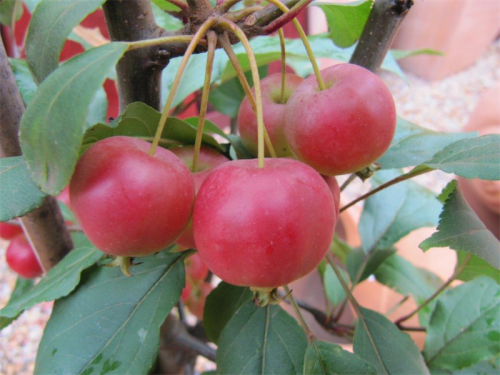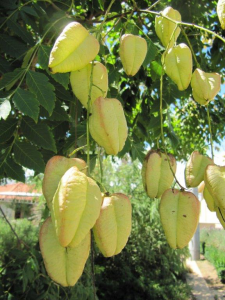Growing to 3m x 3m, it will tolerate most soils, although improving the soil at planting will result in the tree producing more fruit.
In spring the pink buds open to become white-tinged pink blossoms, which are followed by large, crimson-red fruit in summer, the largest fruit of any crabapple.
This is an ideal small tree for a small garden. Most of the larger crabapples are grown for their magnificent displays of spring blossoms rather than their fruit.
ANOTHER small tree ideal for a small garden is the Koelreuteria paniculata or Golden Rain tree.Growing to about 7m high x 7m wide, it provides a wonderful show of yellow flowers in summer followed by the bright-green, lantern-like fruit at this time of the year, which gradually change to yellow and finally rose-brown, giving the appearance of being covered in Chinese lanterns.
They can remain on the tree for several months providing interest throughout the autumn. It was one of the earliest trees grown in China, designated more than 3000 years ago as one of the five official memorial trees and was one to be planted on the graves of scholars.
Sent from one of the early plant hunters in China, it was introduced into Britain in 1763. The Royal Horticultural Society gave it the prestigious Award of Garden Merit in 1932.
I RECOMMEND space be found in every garden for a Aloysia triphylla or more aptly A. citriodora commonly called Lemon-Scented Verbena.
It’s preferable to plant it near a door or alongside a path where the delicious fragrance of its lemon-scented leaves can be brushed against.
Originally from Chile and Argentina, it was introduced into Europe in the 1790s. It was said to have been named after Maria Louisa, the wife of Carlos IV of Spain.
This time of the year it is covered with racemes of small mauve-white flowers.
Growing to 2m-3m, it loses its leaves in winter and in early spring will benefit from a fairly healthy pruning.
The leaves, fresh or dried, make a refreshing tea. Like lavender, its leaves retain their scent for a long time, making them suitable for sachets to deter insects and making potpourri.
When we owned our nursery and herb gardens in Yass, we supplied all the flowers from herbs for a wedding. Lemon Verbena was the principal flower in the bridal bouquet.
AUTUMN is the ideal time for planting evergreen shrubs and perennials. Unlike other cold countries, where the ground freezes solid for months, the frost here only affects a few top centimetres of soil.
This means the soil stays warm through winter enabling roots of evergreen plants to keep growing even though the plant shows no sign of top growth.
Autumn plantings are not subject to the desiccating hot winds and the soil, when watered, stays moist longer.
By springtime, the plants will have a stronger root system.
Jottings…
- For winter colour, plant violas, pansies, polyanthus and primulas. They will take about eight weeks from planting to full flower.
- Lift and divide rhubarb crowns. Dig in well-rotted manure or compost before replanting.
- Plant carpet thyme to cover bare spots in the garden as a living mulch.
- Plant broad bean seeds and broccoli, cabbage and cauliflower seedlings.
- Plant foxglove seedlings at the back of the border for a real spring show.
The post Gardening / Going to jelly for crabapples appeared first on Canberra CityNews.

